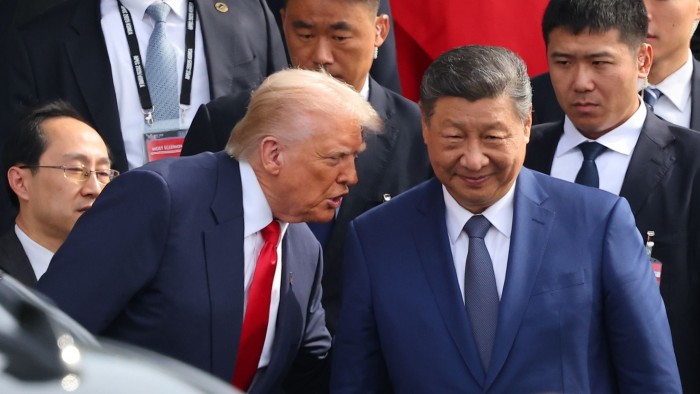China’s President Xi Jinping sought to cement a personal connection with his mercurial American counterpart when he met Donald Trump to hammer out a trade war ceasefire this week.
Xi found common ground with Trump’s “Maga” agenda, which parallels the Communist party’s own ambitions of restoring China’s past glory, known as the “great rejuvenation of the Chinese nation”.
“I always believe that China’s development should go hand in hand with your vision to make America great again,” the Chinese president told Trump at the summit in South Korea on Thursday, their first in-person meeting in six years.
But behind the niceties, the change in the balance of power between the two men was unmistakable. Unlike nearly 10 years ago, when Trump’s first trade offensive caught Beijing by surprise, this time a better prepared and economically more powerful China has been able to fight its once far mightier opponent to a standstill.
Since Trump announced his “liberation day” tariffs in April, Beijing has on at least three occasions blocked Washington from carrying out punitive measures and forced it back to the negotiating table.
The first clash came when Trump increased reciprocal tariffs on China to 145 per cent. Beijing matched these and eventually forced Washington to suspend the levies.
Then the two sides clashed over China’s export controls on rare earths, the production and refining of which it dominates. The rules threatened to shut down US industry and led to another round of talks.
This month, after Washington extended export controls on semiconductors to thousands of subsidiaries of Chinese companies, Beijing announced sweeping new controls on rare earths that again had the US pressing for a truce.
Washington is accepting “that it is now dealing with a peer rival capable of imposing material economic harm on it — a relatively new position for the US and a development which, at least to us, confirms China’s ascendancy to global economic superpower status”, said BNP Paribas in an analyst note.

Xi on Thursday underlined the notion of the two countries as equals by calling on Trump to join him in “sailing” the “giant ship of China-US relations”.
“You and I are at the helm of China-US relations,” the Chinese leader said.
The pair on Thursday agreed to suspend recently announced export controls for one year as well as new levies on shipping. The US, meanwhile, cut 10 percentage points off tariffs on Chinese goods related to fentanyl, reducing the average levy to 45 per cent, while Beijing agreed to resume soyabeans purchases.
Zhao Minghao, professor at the Institute of International Studies at Fudan University in Shanghai, said Xi’s approach at the summit marked a change in rhetoric.
“The basic message is that Beijing wants to seek convergence between its own ‘make China great again agenda’ and Trump’s ‘make America great again agenda’,” Zhao said.
There was room for greater co-operation between the two countries, he said. China needed to stimulate domestic demand and has listed this as a priority for its next five-year plan, which lays out its 2026-2030 economic and industrial blueprint and will be formally released in March.
Recommended
“That means China wants to import more American products — more American good-quality agricultural products, more energy products, more Boeing aeroplanes. So it can open up opportunities,” Zhao said.
“However, it needs relatively stable political, security and diplomatic relations between these two countries.”
But China’s new five-year plan also doubles down on building self-reliance in high-technology industries, science and manufacturing. This is despite oversupply in many industries and a lack of domestic demand that the US says is leading to a wave of exports that undermines other economies.
While the plan emphasises economic growth and consumption, “techno-nationalism remains the paramount priority”, said Teneo analyst Gabriel Wildau in a note.
He said party leaders ultimately believed some overcapacity and waste in industry was a price worth paying “given this approach’s undeniable achievements”.
“These include resilience against US export controls and geopolitical leverage arising from China’s own dominance of rare earths, batteries, and other industries,” he added.

This makes further US-China tensions inevitable, analysts said. Most of the agreements between Xi and Trump on Thursday were relatively narrow and mostly suspended existing punitive measures rather than scrapping them altogether.
“Both sides appear to be maintaining leverage for future negotiations by keeping these measures as bargaining chips,” said Chaoping Zhu, Shanghai-based global market strategist with JPMorgan Asset Management.
“Broader trade and technology competitions persist. While the summit has stabilised short-term expectations, significant differences remain,” he added.
The two sides remain at loggerheads over geopolitical issues ranging from China’s claims of sovereignty over Taiwan and the South China Sea to its support for Russia in the Ukraine war.
Recommended
Fudan’s Zhao said: “This summit can only bring about a tactical détente rather than a strategic reset for the US-China relations.”
Globally, the US is still without a peer on many fronts, said Han Shen Lin, China country director for US consultancy The Asia Group, pointing to its control over “foundational technologies” such as chips, its giant consumer market, the dollar’s status as the reserve currency and its network of allied nations, though this pre-eminence was “a bit frayed”.
But China was “playing a long game”, he said, using its domestic market as a buffer and its dominance of manufacturing and critical minerals.
“While the US can dictate the pace and pressure of the conflict in the short term, China is digging in for a protracted struggle,” Han said. “It’s less about who has the ‘upper hand’ now, and more about who is better positioned for a long-term contest.”
Additional reporting by Edward White in Shanghai




